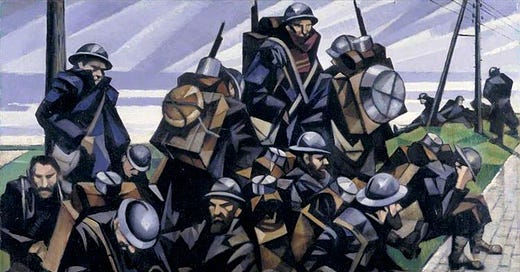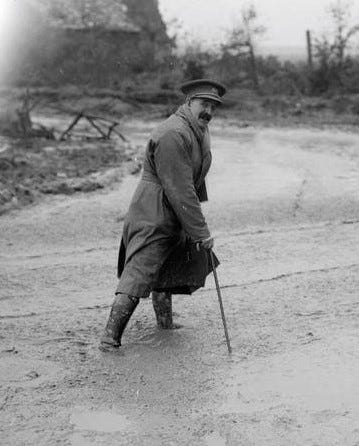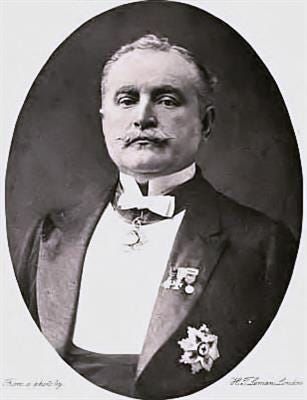The art of war is back in the public eye with a new opportunity to view paintings of the World War One at London’s Imperial War Museum (IWM), which is now making much better use of its extraordinary collection of war art thanks to the considerable donation which has enabled the IWM to create the Blavatnik Art, Film and Photography Galleries.
At the Blavanik Galleries today visitors can see many of the most famous WW1 images - including John Singer Sargent’s “Gassed” - and it is good to see the IWM making up for the lost opportunities to display these works since Britain abandoned the plans, made a century ago, for a spectacular commemorative gallery as originally intended by Lloyd George’s Government immediately after the conflict.
For more on the story behind Britain’s lost memorial gallery see my previous Substack here:-
The official war artists of WW1 and their work are endlessly fascinating to me. Sent out to France wearing khaki uniforms, sponsored by the British Government to create contemporaneous images of the fighting, they were part of a revolution in the commissioning and use of art. Working on the battlefields, just behind the lines, mixing directly with the troops and often sharing their hardships and perils, these artists were true witnesses to war.
From the arrival in France of Muirhead Bone, the first official war artist in 1916, until the peace talks which ended the conflict, a total of 90 artists were signed up and they produced, in total, more than 5,000 works which became the property of the State. Later they passed to the IWM, after an inter-department scrap between two Government ministers.
There are many remarkable accounts of the war artists in that period, but when poring through the archives of the official war artist project for a dissertation I came across the poignant tale of a renowned British artist who failed to get in to the programme, despite several attempts, and for whom that failure led to a professional decline and a tragic death.
Of course, art and war were far from strangers as the 19th century turned into the 20th. There had long been a symbiotic relationship between the British military and the artists who portrayed them. Military action had become one of art’s major economic engines a century or more before WW1, as prestigious regiments commissioned retrospective images of their victories. The Dictionary of British Military Painters lists more than 400 painters who were active between 1750 and the early years of the 20th century. Yet Europe’s Great War of 1914-18 disrupted the relationship between artists and war painting as fundamentally as it changed so much else in the military and civilian worlds.
WW1 was a conflict which began on horseback and went on to witness the beginnings of “Techno-war” - high-tech, capital-intensive warfare fought by machines as well as men, with the ruthlessness and efficiency of the production line. The old order of battle painting was cast aside, along with the cavalry charge and the cutlass. Famous artists whom the British public associated with military art prior to 1914 were refused all access to the fighting. Instead, a cadre of relatively unknown painters, many recently out the country’s most advanced art school, who had never experienced war, were selected by the Government’s propaganda unit to don khaki and paint at the Front.
In the words of Sir Charles Holmes, who was Director of the National Gallery 1916-1928, writing in the Manchester Guardian in 1920, Britain had produced ‘a new artistic movement ….. as novel and startling as the first works of the Pre-Raphaelite Brotherhood.’
The names of those official war artists are well known today – it could be argued that for many of them the work they did in France and other theatres of war, was the making of their careers. In contrast there were many established artists who felt they should have been chosen and the Pictorial Propaganda Committee (the Government body which created the Official War Artist scheme) was often pressured to recruit established battle painters who felt they had a greater claim to painting commissions in France than the avant garde painters being sent out.
One of those who was most famously rejected, on more than one occasion, and who felt the slight more deeply than any others, was Richard Caton Woodville. He made several attempts to join the other artists in France or at the other front lines and was still petitioning for a place on the scheme at the very end of the War. The Minutes of the PPC meeting on 6 November 1918 record a final application from Caton Woodville to be selected as a war artist, although his name is mis-spelled as “Carton Woodville”. Their decision was that Caton Woodville’s application should be - in the rather ugly language of the Minutes – ‘negatived’. It was a huge blow to Woodville and he took it badly.
For the previous 30 years Caton Woodville had been in the forefront of battle painting. Art was in the Woodville genes, as his American father had earned his living in the same trade before a tragically early death from a morphine overdose. Richard was born in London and educated in Germany and had two tandem careers. His bread and butter income came from working as a “special artist” for the illustrated newspapers which were massive sellers in Victorian times. Caton Woodville was often commissioned by the extremely popular Illustrated London News and travelled widely in support of the War Correspondents sending home glamorised stories of British heroism. Even the birth of photography did not displace the gory action images from South Africa or the Crimea by illustrators such as Woodville. As the camera doesn’t lie, the images couldn’t be edited then as they routinely are today. Black and white photos were just too dull and indistinct to sell papers.
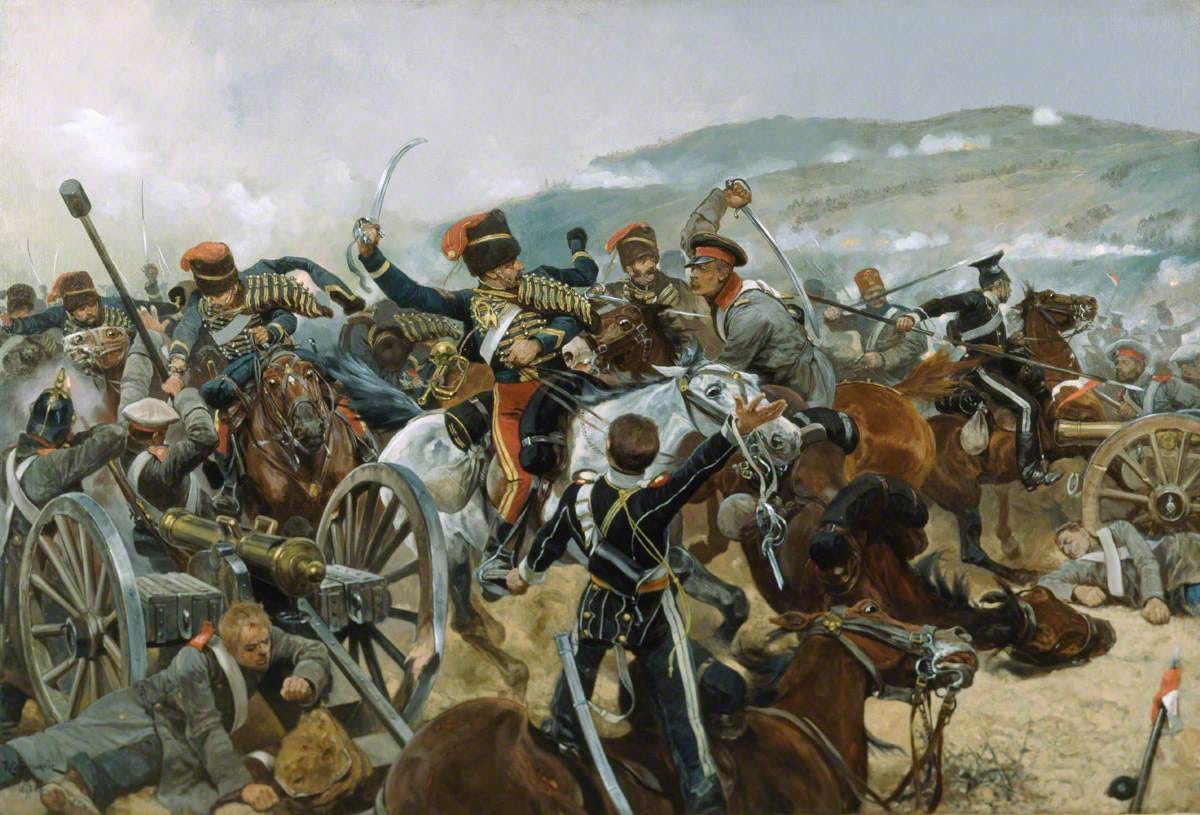
Caton Woodville could be relied upon to show war as the Editors wanted the public to see it.
Having built a reputation for creating images of history in ink and wash, Caton Woodville was often the first choice to create the giant commemorative oil paintings destined to hang in regimental HQ’s and Government offices when the conflicts were over. His skill and style appealed to the public, too, and his paintings were a major draw at Royal Academy exhibitions where he showed a total of 21 major works over his lifetime.
He didn’t have the market all to himself of course. One of the most successful of artists feeding this appetite was Elizabeth Thompson (Lady Butler) (1846-1933) - successful, but certainly not typical, in that she was a woman, a fact which fascinated the art world. Jean Meissonier, a French military artist, wrote in 1890 praising Thompson: ‘England has only one military painter – it’s a woman’. She had studied in London and in Florence and achieved fame in her early 30s in 1874 when her Crimea oil The Roll Call, showing the exhausted remnants of a battalion of Grenadier Guards, was exhibited. Even before her 1877 marriage to General William Butler, Thompson enjoyed significant co-operation from the army, as did Caton Woodville. It was not unusual for serving soldiers, plus horses, uniforms and weaponry, to be put at their disposal in order that artists could recreate of battle scenes.
In her autobiography Thompson writes candidly about the co-operation she enjoyed: ‘One day the Horse Guards […] had a magnificent black charger thrown down in the riding school at Knightsbridge (on deep sawdust) for me to see, and get hints from, for the fallen horse in my foreground. The riding master strapped up one of the furious animal’s forelegs […] What a commotion before he fell! How he plunged and snorted in clouds of dust.’
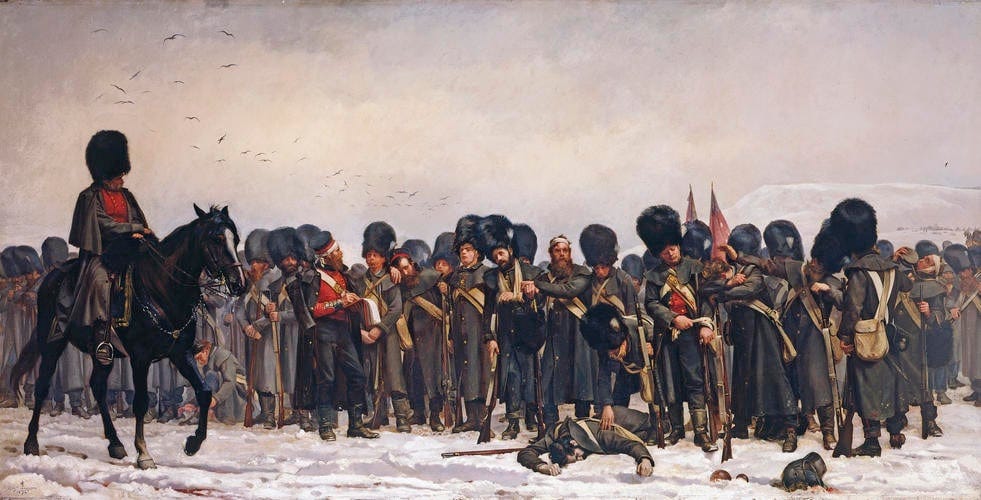
Caton Woodville had become wealthy from his pre-war battle painting, although two divorces and numerous financial catastrophes eventually absorbed everything he made. In a bankruptcy hearing in 1905, he was said to have liabilities of £14,000 - which equates to a spending power of £2 million today.
For a while after WW1 ended, his old contacts in the Army brought him commissions for several commemorative works which showcased the gallantry of leading Regiments. Right up until his death in 1927 he was producing commemorative works - his final one, Stand of the London Scottish on Messines Ridge, was exhibited at the Royal Academy just before his death. But his was no longer the war art which the public really wanted to see. Caton Woodville’s works hung mostly in Officers’ Messes of prestigious regiments and not in the public galleries where thousands queued to see work from the likes of William Orpen, Christopher Nevinson and Augustus John.
It would have crowned a significant career in painting and illustration for a man who had worked alongside troops in South Africa and other significant pre-WW1 conflicts to have been accepted for official war work and to remain at the top of his profession alongside the new men. The rejection was hugely damaging to Caton Woodville. His income tailed off to virtually nothing during the post-war years. On the afternoon of Wednesday, 17 August 1927, he sat down at his desk in his St John’s Wood studio and wrote: ‘I am finished. I cannot stick it any longer.’ He picked up his pistol and shot himself.
When details of his will were published, his entire estate was probated at just £10.
The Blavatnik Galleries are at the IWM, Lambeth Rd, London, SE1 6HZ. |There are more than 500 works from the IWM’s collection of 20th and 21st art, including film and photography. The Galleries are free to enter.

